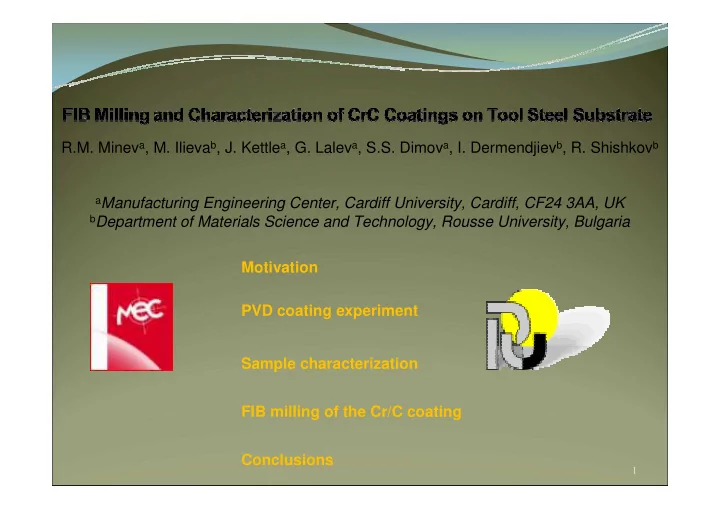

R.M. Minev a , M. Ilieva b , J. Kettle a , G. Lalev a , S.S. Dimov a , I. Dermendjiev b , R. Shishkov b a Manufacturing Engineering Center, Cardiff University, Cardiff, CF24 3AA, UK b Department of Materials Science and Technology, Rousse University, Bulgaria Motivation PVD coating experiment Sample characterization FIB milling of the Cr/C coating Conclusions 1
Motivation Hard coatings: CrC, CrN, CrN(C), TiN, TiC, TiN(C) (N atoms might be replaced by C) Complex of extreme properties useful for ( µ µ )tooling: µ µ -hardness, -wear resistance, -scratch resistance, -corrosion resistance’ -low adhesion to the glass, polymers or metals. metal master 2
Motivation Concurrent material (CrC) and process (FIB) optimisation 3
PVD coating experiment Table 1 Ion etching and coating conditions Tc=500 o C Cleaning temperature Time of cleaning t c =10 min The Ar gas flow rate (standard cubic centimetres per minute) G Ar =28.6 sccm Pressure in the vacuum chamber during the cleaning P c =15 Pa Pressure during the deposition of coating P d = 0.45 Pa Temperature during T d = 450 o C the deposition Time for deposition t d =120 min The Ar gas flow rate G Ar =11.4 sccm The CH 4 gas flow rate G CH4 =7 sccm Discharge voltage U=460V Discharge current I=7A Distance between the target and substrate L t-s =70 mm 4
Sample characterization 3500 I 3300 Cr 7 C 3 [801] 3100 Fe [200] 2900 Cr 7 C 3 [321] Cr 7 C 3 2700 Cr 7 C 3 [421] 2500 [102] Fe [110] 2300 Cr 7 C 3 2100 [312] 1900 1700 1500 40 50 60 70 80 90 2 Θ ° Fig.1 X ray diffraction patterns of Cr/C 5 coatings onto the tool steel substrate.
Sample characterization CrC Fig.2 DIC (differential interference contrast) picture of the CrC coating onto D2 tool steel. 6
Sample characterization Fig. 3 Stages of the TEM Lamellae preparation using FIB in both milling and deposition mode and subsequent nano-manipulation of the prepared lamellae (x3500). 7
Sample characterization Fig. 4 STEM image of the CrC lamellae. Fig. 5 Grain size distribution of the Cr/C coating. 8
FIB milling of the Cr/C coating Fig.6 FIB milled patterns produced with different ion beam current ( I ion ) and time ( t s ). Number of layers NL=1 9
FIB milling of the Cr/C coating The ion fluence in nC/µm 2 : × I t = ion s f i A where: I ion , nA - the target ion beam current of charged Ga + ions; A , µ m 2 - the target area size of features. ( i ) High milling rates (>1 µm 3 /min): I ion > 1 nA; t s > 60 s; f i > 2.3 nC/µm 2 ; ( ii ) Best surface quality: I ion =0.1- 0.5 nA; t s = 30-300 s; f i = 0.4- 0.5 nC/µm 2 ; ( iii ) Compromise between ( i )&( ii ): I ion ∼ 0.5 nA; t s = 30-300 s; f i ∼ 0.9 nC/µm 2 10
FIB milling of the Cr/C coating Fig. 7 Depth of FIB milling as a function of I ion and t s . (on x-axis: FIB current according to the legend) 11
FIB milling of the Cr/C coating 5 4 Depth, µ m 3 2 Fig. 8 Depth of FIB milling 1 as a function of f i . 0 4.7 2.3 2.3 1.9 0.9 0.9 0.9 0.5 0.4 0.4 Fluence, nC/ µ m^2 80 60 SD 40 20 Fig. 9 The influence of f i on surface quality. 0 4.7 2.3 2.3 1.9 0.9 0.9 0.9 0.5 0.4 0.4 12 Fluence, nC/ µ m^2
FIB milling of the Cr/C coating Fig.10 FIB milled CrC I ion =200mA, t s =120s, NL=1 (a) reduced dwelling time: NL=50 (b). -selective sputtering -local redeposition 35 30 Surface Roughness, ra 25 20 Fluence 1 Fluence 2 15 10 5 Ra (measured by AFM) 0 as a function of NL 0 5 10 15 20 25 30 35 40 45 13 Number of loops
Amorphous and polycrystalline Ni workpiece for performing FIB milling 14
Conclusions PVD coatings were produced in thicknesses of about 30µm suitable for micro functionalisation of the surface. The stoichiometric composition of the coating material was x-ray determined to be Cr 7 C 3 . The properties of the nano structured (10nm average grain size) surface layers demonstrated good mechanical properties (MHV 0.025 = 1400), superb corrosion resistance and good adhesion (measured by scratch tests). The experiments showed that to achieve a good surface finish with sputtering rates of approximately 1 µm 3 /min the FIB milling of the CrC coatings should be carried out with ion fluence of around 0.9 nC/µm 2 . The best processing strategy is to use a higher number of layers in order to reduce the re-depositioning effect and improve the surface quality. 15
Recommend
More recommend